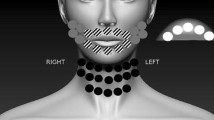Summary
The activity of up to 4 motor units was recorded simultaneously with electrodes placed in the masseter muscle in human subjects. Mildly noxious electrical shocks were applied to the ipsilateral lip while one of the units was kept firing at a steady frequency by voluntary control. The pattern of reflex responses of each of the units was determined, and spike-triggered averaging was used to measure the potential that each action potential contributed to the rectified surface electromyogramme (EMG). Finally, the average contribution made to the surface EMG by each unit throughout the whole course of the reflex was determined. The contribution of each unit to the reflex response in the surface EMG was found to depend on its firing frequency throughout the course of the response, and on its amplitude measured at the surface. The timing of the various phases of inhibition and activation of different units depended on their pre-stimulus firing frequency. In a given bite, the lowest-threshold units were more likely to be firing most rapidly, and these were least susceptible to the inhibitory stimulus. Higher-threshold units tended to produce larger potentials at the muscle surface but, because they fired more slowly in a given bite, they were more powerfully inhibited by the stimulus. Most units showed the same general pattern of inhibitory and excitatory activity that can be seen in the surface EMG. However, the timing of these various phases in the surface EMG did not necessarily correspond with the timing of inhibition and activation in the records of individual units. Rather, the surface signal is the sum of many similar, but out-of-phase frequency changes in the motor units of which it is constituted.
Similar content being viewed by others
References
Buchtal F, Guld C, Rosenfalck P (1957) Volume conduction of the spike of the motor unit potential investigated with a new type of microelectrode. Acta Physiol Scand 38: 331–354
De Luca CJ (1979) Physiology and mathematics of myoelectric signals. IEEE Trans Biomed Eng 26: 313–325
Goldberg LJ, Derfler B (1977) Relationship among recruitment order, spike amplitude and twitch tension of single motor units in human masseter muscle. J Neurophysiol 40: 879–890
Miles TS, Türker KS, Nordstrom MA (1986) Reflex responses of motor units in human masseter muscle to electrical stimulation of the lip. Exp Brain Res 65: 331–336
Miles TS, Türker KS (1986) Does reflex inhibition of motor units follow the “size principle”? Exp Brain Res 62: 443–445
Milner-Brown HS, Stein RB, Yemm R (1973) The contractile properties of human motor units during voluntary isometric contractions. J Physiol (Lond) 228: 285–306
Person RS, Kudina LP (1972) Discharge frequency and discharge pattern of human motor units during voluntary contraction of muscle. Electroencephalogr Clin Neurophysiol 32: 471–483
Schmid K, Böhmer G (1985) Instantaneous frequency meter with averaging capability based on interval duration measurement. Electroencephalogr Clin Neurophysiol 60: 90–92
Türker KS, Miles TS (1985) The effect of stimulus intensity and gape on electrically-evoked jaw reflexes in man. Arch Oral Biol 30: 621–626
Yemm R (1977) The representation of motor unit action potentials on skin surface electromyograms of masseter and temporal muscles in man. Arch Oral Biol 22: 201–205
Author information
Authors and Affiliations
Rights and permissions
About this article
Cite this article
Miles, T.S., Türker, K.S. Decomposition of the human electromyogramme in an inhibitory reflex. Exp Brain Res 65, 337–342 (1987). https://doi.org/10.1007/BF00236306
Received:
Accepted:
Issue Date:
DOI: https://doi.org/10.1007/BF00236306




